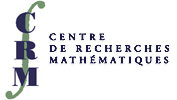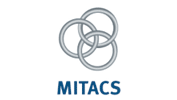 |
|
||||
Org: Ed Bierstone (Toronto), Leticia Brambila (CIMAT), Jacques Hurtubise (McGill) and Jose Seade (UNAM)
[PDF]
- JANUSZ ADAMUS, The University of Western Ontario, London, Ontario, N6A 5B7, Canada
Geometric Auslander criterion for flatness [PDF] -
Flatness is a subtle algebraic notion that expresses continuity of the fibres of a mapping, but it has remained geometrically elusive. The aim of this talk is to understand the notion of flatness in explicit geometric terms. We show that non-flatness of a morphism of schemes of finite type with a regular target of dimension n manifests in the existence of the so-called vertical components in the n-fold fibred power of the morphism (i.e., components with a nowhere dense image). This leads to an effective algorithm for flatness over regular affine algebras, by means of Grobner bases.
This work was done with E. Bierstone and P. D. Milman.
- EDWARD BIERSTONE, Fields Institute, 222 College Street, Toronto, Ontario, Canada, M5T 3J1
Resolution except for minimal singularities [PDF] -
Can we find the smallest class of singularities S with the following properties:
(1) S includes all normal-crossings singularities;
(2) every reduced variety X admits a birational morphism s: X¢® X such that X¢ has only singularities in S, and s is an isomorphism over the locus of points of X having only singularities in S? - LETICIA BRAMBILA, CIMAT A.C. Jalisco S/N Mineral de Valenciana 36240, Guanajuato, Guanajuato, Mexico
Moduli of coherent systems [PDF] -
Coherent systems are the analogous for higher classical linear systems. That is, a coherent system of type (n,d,k) is a pair (E,V) where E is a holomorphic bundle of rank n and degree d and V is a linear subspace of its space of holomorphic sections of dimension k. There is a stability notion for a pair (E,V), distinct from the stability of the bundle E. The natural definition of such stability depends on a real parameter a and leads to a finite family of moduli spaces of a-stable coherent systems. In this talk we will describe such moduli spaces for certain values of (n,d,k).
- PATRICK BROSNAN, University of British Columbia
Essential dimension for moduli stacks [PDF] -
I will present joint work with Angelo Vistoli and Zinovy Reichstein on essential dimension of the moduli stacks of curves and of abelian varieties. The main technical result used to compute this essential dimension is a "genericity theorem" which reduces the computation of the essential dimension of a smooth Deligne-Mumford stack to the essential dimension of its generic gerbe. I will sketch the proof of this result.
- JIM BRYAN, Department of Math, UBC
The Donaldson-Thomas and Gromov-Witten theory of orbifolds and their resolutions [PDF] -
There are two primary theories of "curve counting" on a Calabi-Yau threefold, Donaldson-Thomas theory and Gromov-Witten theory. Both theories extend to Calabi-Yau orbifolds. A three dimensional Calabi-Yau orbifold X has a canonical Calabi-Yau resolution Y. The four curve counting theories DT(X), DT(Y), GW(X), and GW(Y) are expected to be equivalent. We give an overview of these theories and conjectural equivalences.
- VICTOR CASTELLANOS, Universidad Juarez Autonoma de Tabasco, Av. Universidad s/n Zona de la Cultura, Col. Magisterial, 86040 Villahermosa Tabasco, México
A Singular computation of the Poincaré-Hopf index of real-analytic vector fields [PDF] -
In this talk we present a generalized algebraic index formula for certain class of real-analytic vector fields with non-algebraically isolated singularities. In the algebraically isolated case, we compute the index with the library PHindex writing for the software Singular, using the Eisenbud-Levine-Khimshiashvili's algebraic index formula.
- ABEL CASTORENA, IMUNAM-Morelia(Universidad Nacional Autonoma de Mexico), A.P. 61-3 (Xangari), CP 58089, Morelia, Mexico
A family of curves in the Severi variety with special moduli [PDF] -
Let C be an smooth complex algebraic curve of genus g ³ 8. Denote by KC the canonical line bundle on C. Let |L| = g1g-2 a pencil on C free of base points such that the residual g2g of the g1g-2 determines a birational map onto a plane curve of degree g and geometric genus g with d = [((g-1)(g-2))/2] nodes as singularities. Consider the Petri map mL : H0(C,L) ÄH0(C,KC ÄL-1) ® H0(C,KC). We show that mL is not injective if and only there exists a curve F of degree g-5 containing d-1 nodes of G.
Now consider the Severi Variety Vg,g,d of reduced and irreducible plane curves of degree g and genus g having d nodes as singularities. Let Vg : = {G Î Vg,g,d : d-1 nodes lie on a curve of degree g-5}. Let f: Vdg,g ® Mg the natural morphism to the moduli space of curves Mg. We show that the image f(Vg) is a divisor in Mg. We discuss the irreducibility of f(Vg) in some cases.
- JOSE LUIS CISNEROS, Universidad Nacional Autónoma de México, Instituto de Matemáticas, Cuernavaca, México
Refinements of Milnor's Fibration Theorem for complex singularities [PDF] -
Given a holomorphic map-germ f : (Cn,0) ® (C,0) with a critical value at 0 Î C, there are two equivalent ways of defining its Milnor fibration. The first is:
where K = f-1(0) ÇSe is the link. The other, given essentially by Milnor himself by:f = f |f|: Se \K ® S1,\tag1 (1)
where e >> h > 0 are sufficiently small, Dh Ì C is the disc of radius h around 0 Î C, Be is the ball of radius e around 0 Î Cn and N(e,h) is the Milnor tube Be Çf-1 (¶Dh). (We remark that Milnor only proved that the fibres of (2) are equivalent to those of (1), and not that (2) is actually a fibre bundle; this was certainly known to Milnor when f has an isolated critical point, and later completed by Lê.)f : N(e,h) ® ¶Dh,\tag2 (2) We show that there is a canonical decomposition of the whole ball Be into real analytic hypersurfaces Xq that spin around their "axis" Ve = f-1(0) ÇBe forming a kind of "open-book" with singular binding. Using this decomposition we improve, or refine, Milnor's fibration theorem in several directions.
This is joint work with J. Seade and J. Snoussi.
- PEDRO LUIS DEL ANGEL, Centro de Investigacion en Matematicas A.C.
Variations of Mixed Hodge Structures associated to a singular family of Calabi-Yau 3-folds [PDF] -
We consider a particular family of singular Calabi-Yau 3-folds parametrized by U = P/1 - {q1,...,q6}. The singular locus of the fiber over u consists of exactly 100 nodes for every u Î U.
We study the monodromy action and in particular the variation of Hodge structure associated to the smooth family of the desingularizations.
- MARCO GUALTIERI, University of Toronto, Toronto, ON
Holomorphic Poisson structures [PDF] -
Holomorphic Poisson manifolds are highly constrained compared to their relatively flexible smooth counterparts. I shall describe some new results concerning the structure and classification of holomorphic Poisson manifolds.
- JACQUES HURTUBISE, Dept. Mathematics, McGill University, 805 Sherbrooke St. W., Montreal H3A 2K6
Moduli of instantons and calorons [PDF] -
The moduli spaces of instantons on the four-sphere and of calorons (instantons on the circle times R3) turn out to be describable in terms of holomorphic maps from the Riemann sphere into a flag manifold of a loop group. These in turn, like for their finite dimensional cousins, admit a poles and principal parts description that allows one to describe the moduli and prove, for example, a topological stability theorem for the moduli.
Joint work with Michael Murray.
- KIUMARS KAVEH, University of Toronto, 40 St. George St., Toronto, ON
Convex bodies for actions of reductive groups [PDF] -
Let X be a algebraic variety equipped with an action of a reductive algebraic group G. Also let L be a finite dimensional subspace of rational functions invariant under G. In this talk we discuss various convex bodies that one can associate to (X,L) which encode information about number of solutions of generic systems of equations from L plus information on multiplicities of irreducible representations appearing in powers Lk. Similarly one associates convex bodies to a projective G-variety X and a G-linearized line bundle L on X. These far generalize the notion of Newton convex polytope in toric geometry as well as Gelfand-Cetlin polytopes associated to irreducible representations of GL(n) (i.e., flag variety of GL(n)).
This is a joint work with A. G. Khovanskii.
- RUXANDRA MORARU, University of Waterloo
Compact moduli spaces of stable bundles on Kodaira surfaces [PDF] -
In this talk, I will examine the geometry of moduli spaces of stable bundles on Kodaira surfaces, which are non-Kaehler compact surfaces that can be realised as torus fibrations over elliptic curves. These moduli spaces are interesting examples of holomorphic symplectic manifolds whose geometry is similar to the geometry of Mukai's moduli spaces on K3 and abelian surfaces.
- JOSE SEADE, Universidad Nacional Autónoma de México, Instituto de Matemáticas, Cuernavaca, México
On the Chern classes of singular varities [PDF] -
The Chern classes of complex manifolds are important invariants that appear in many fields of geometry and topology. From the topological viewpoint, these are closely related to the local index of Poincaré-Hopf for vector fields, and generalizations of it to the case of sections of certain fibre bundles associated to the tangent bundle. It is natural to ask whether one has similar notions for complex analytic varieties. This is a question that goes back to the work of M. H. Schwartz in the 1960s, MacPherson in the 1970s, and many others after that. In this talk I will speak about work done mostly with Jean-Paul Brasselet and Tatsuo Suwa. We relate this problem with that of studying indices of vector fields on singular varieties, and the various generalizations one has for singular varieties of the concept of tangent bundle.






